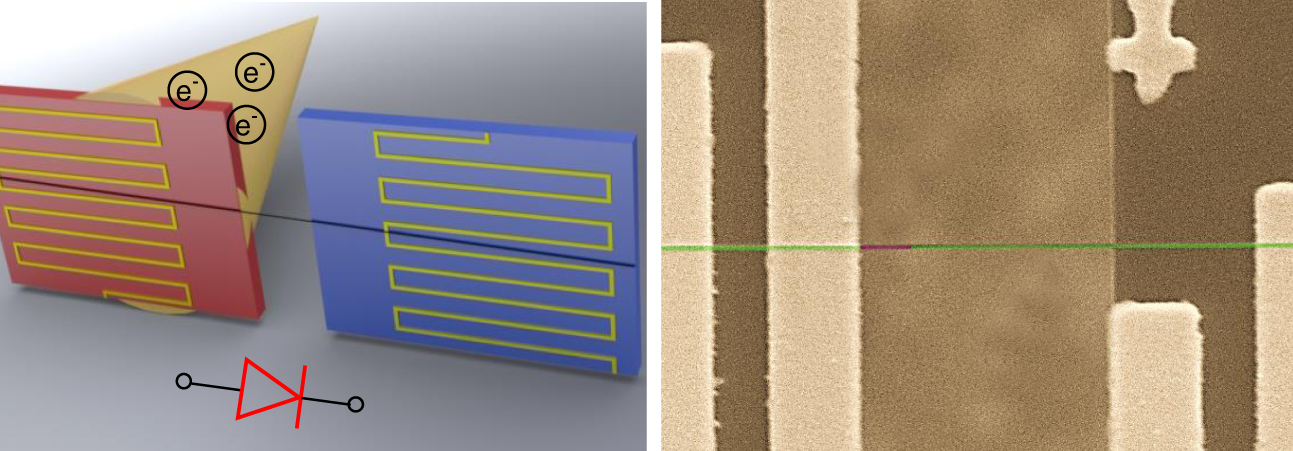Hot Stuff: Unusual thermal diode rectifies heat in both directions
Dual-mode thermal rectification could be a game changer for a range of industrial and medical applications.
You can feel it on your laptop and mobile phone. It’s behind your refrigerator and office copy machine. While heat is desirable for appliances like a coffee maker, it can jeopardize the reliability and safety of electronic systems in other devices, causing premature failure at best and explosions at worst.
Active control of heat transport, as with thermal switches and thermal diodes, is important for a range of applications in heating and cooling, energy conversion, materials processing, and data storage. In practice, thermal diodes are highly desirable thermal components for many engineering applications because they allow energy systems to transfer heat to designated areas while also protecting them when the surrounding temperatures are too high.
Sheng Shen, a professor of mechanical engineering at Carnegie Mellon University, explores exotic thermal transport phenomena like thermal rectification in his laboratory. He recently led a research team that developed an unusual thermal diode made of polyethylene (PE) nanofiber that rectifies heat in both directions by changing the working temperature. This is significant because until now, achieving a large and adaptable rectification effect required a macroscale size or a great temperature bias. The findings were published in Nature Communications.
The nanoscale thermal diode developed in this work enables a record high thermal rectification effect beyond any reported experimental values for solid-state thermal rectification, and only requires a small temperature bias of less than 10 Kelvin.

Source: College of Engineering
(Left) Schematic of a nanofiber thermal diode device; (Right) Scanning electron microscopy image of the heterogeneous nanofiber junction as a thermal diode in false colors: purple (irradiated section) and green (pristine section).
To fabricate this dual-mode solid-state thermal diode, Xiao Luo, Ph.D. student and a co-leading author of the paper, tuned the crystalline PE nanofiber with electron beam irradiation. In its original state, PE nanofiber at a low temperature has high thermal conductivity but its conductivity significantly decreases after it undergoes a temperature-induced phase transition around 450 degrees Kelvin.
Luo irradiated one part of the PE nanofiber, reducing thermal conductivity and shifting the phase transition temperature lower. The remaining part of the PE nanofiber—the “pristine” part—was left as in the original state, creating a pristine-irradiated junction.
“As a result, we have a hetero-junction, with the two parts of the junction having different properties,” said Luo. Because the pristine and irradiated parts undergo their respective phase transitions at different temperatures, heat can be rectified in both directions depending on the specific temperature. The dual-mode thermal rectification can potentially be used to regulate heat flow actively for advanced thermal management and energy conversion—a real game changer for a range of industrial and medical applications.
They can potentially be used to protect biological samples or biomedical devices from local heat spikes.
Sheng Shen, Professor, Mechanical Engineering
“As advanced thermal control elements, thermal diodes can be used to protect temperature sensitive electronic or biomedical devices from environmental temperature fluctuations,” said Shen. “For instance, the nanofiber thermal diodes developed in this work are fully biocompatible and flexible. They can potentially be used to protect biological samples or biomedical devices from local heat spikes and enable precision temperature stabilization based on the dual-mode thermal rectification effect.”
The paper was a collaborative effort between researchers at Carnegie Mellon University, University of California at San Diego, University of Notre Dame, and the Institute of Materials Research and Engineering. In addition to Shen and Luo, Michael Bockstaller, professor of materials science and engineering, is a co-author.
